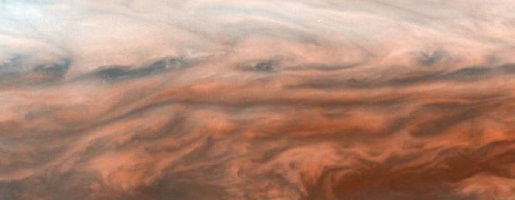 |
||
|
The
equatorial region of Jupiter's atmosphere.
|
||
| JUPITER - THE LARGEST PLANET | ||
| Jupiter, the largest and most massive planet of the Solar System, rules the midnight sky, and was regarded by the Romans as the lord of the planets. The Greeks too identified Jupiter as the most powerful god - Zeus. Although Venus shines more brightly, it sets soon after the Sun, whereas Jupiter dominates the sky through the night and has been part of folklore for thousands of years. Orbiting the Sun at an average distance of 778 million kilometres, Jupiter marks the beginning of the realm of the gas giants. | ||
| Distance from Earth | ||
| It is a huge jump from Earth to Jupiter - the inner planets are all quite close to Earth, with Venus coming as close as 41 million kilometres. Jupiter can't come closer than 588 million kilometres, over 14 times the distance. It takes months for a spacecraft to reach Mars, but years to visit Jupiter. | ||
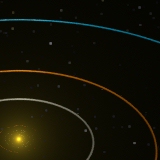 Jupiter's orbit. |
 Jupiter's orbit. |
|
| The Gas Giant | ||
| It is appropriate that Jupiter is named for the lord of the gods, as the planet contains about 70% of all the planetary mass in the Solar System. Its volume can contain 1300 Earths and its mass is over 321 times that of Earth. | ||
| However, being a gas giant and primarily composed of hydrogen, it has a low density, similar to the Sun's. In fact, its chemical composition is nearly solar. Jupiter's large size and mass lead many to consider Jupiter to be less of a planet and more of a failed star. | ||
 Comparison between Jupiter and the Earth. |
 The interior structure of Jupiter. |
|
| With such a large mass, Jupiter perturbs the orbits of other planets and comets, and may in the past have been responsible for collisions between asteroids and the Earth. Jupiter's rotation rate is so rapid (under ten hours), that the planet bulges at the equator, and its non-spherical shape can be seen even in small telescopes. | ||
| The Mysterious Interior | ||
| Very little is known of Jupiter's interior. Spacecraft missions have only been able to analyse the outer layers of Jupiter's atmosphere. Knowledge of Jupiter's structure comes from theoretical models. Nevertheless, it is certain that extreme conditions exist within the depths of Jupiter - searing temperatures and crushing pressures. | ||
| More about Jupiter's interior | ||
| A Powerful Magnetism | ||
| Jupiter has a powerful magnetic field originating deep in the planet, making Jupiter a strong radio transmitter, and creating auroral displays. Jupiter has the strongest magnetic field of all the planets, and at some wavelengths the magnetosphere even radiates more energy than the Sun. Such a strong magnetosphere has an impact on the satellites in orbit around Jupiter. | ||
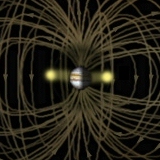 The powerful magnetosphere of Jupiter. |
||
| More about Jupiter's magnetic field | ||
| Where Gas turns to Metal | ||
| Jupiter has an atmosphere at least 60,000 kilometres deep, with temperatures and pressures so severe that hydrogen gas turns to metal, and with supersonic wind speeds. Much of Jupiter's deep atmosphere is unknown and unexplored - we perceive only the outermost layers, and have only sent one probe into the clouds. | ||
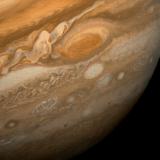 Voyager image of Jupiter's atmosphere and the Great Red Spot. |
||
| The upper layers of the atmosphere circulate in a series of belts and zones, with different colours representing different cloud heights and chemistry. What is the cause of the belt and zone stability ? Jupiter's atmosphere is home to the "Great Red Spot", a storm that is not only bigger than the Earth, but has persisted for over 300 years. | ||
| More about Jupiter's atmosphere | ||
| A Failed Star? | ||
| How did Jupiter get to be so massive, and why is it considered to be a failed star? There is great uncertainty concerning the early Solar System and the chemical history of planets, and theories of Jupiter's origin must also be able to explain today's observations. | ||
| More about Jupiter's evolution | ||
| Rings | ||
| Like the other gas giants, Jupiter too has a ring system, though it is nowhere near as spectacular as Saturn's ring system. The rings are very thin and insubstantial, and indeed are more transparent than glass. Particles can only remain in the ring system for 1,000 years or so, and if the ring system is a permanent feature, it has to be constantly fed with new material - what is the source of Jupiter's rings? | ||
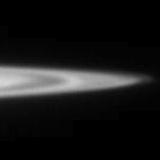 The tenuous ring system of Jupiter. |
||
| More about Jupiter's rings | ||
| The Moons of Jupiter | ||
| Jupiter has a family of 16 moons, with a wide variety of sizes, structure, and surfaces. The family includes Io, a moon of exceptional volcanic activity, and Europa, whose surface may hide an ocean. The moons do not merely orbit Jupiter, rather, they engage in a complex interaction with their parent planet involving gravity, magnetism, and even dust. | ||
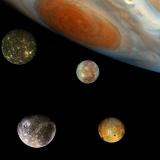 Jupiter's Galilean moons against a backdrop of the Great Red Spot. |
||
| More about Jupiter's moons | ||
| Jupiter's asteroids | ||
| Jupiter is accompanied in its orbit by the Trojan asteroids, running both ahead and behind the planet. Over four hundred Trojan asteroids have been identified, trapped at gravitationaly stable points, possibly for the entire history of the Solar System. | ||
 The orbital distribution of the Trojan asteroids. |
||
| More about Jupiter's asteroid family | ||
| Shoemaker-Levy | ||
| One of the most widely-observed events in the Solar System occurred in 1994, when the fragments of a shattered comet, Shoemaker-Levy 9, collided with Jupiter. The event was witnessed by observatories around the world, and even by spacecraft. | ||
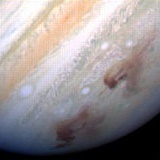 Hubble Space Telescope view of the Shoemaker-Levy crash site. |
||
| Exploration of Jupiter | ||
| Visited by Pioneer, Voyager, and more recently, Galileo, Jupiter has slowly revealed some of its inner workings. The most recent mission involved dropping a probe deep into the atmosphere. | ||
| More about the exploration of Jupiter | ||
|
|
||